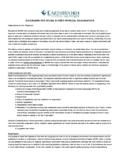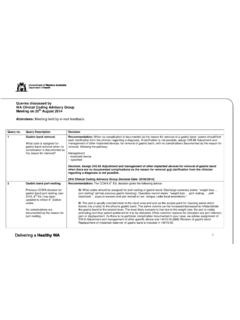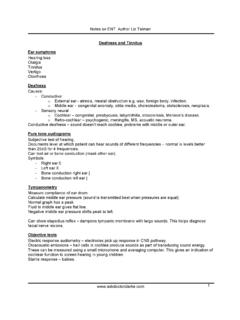Transcription of TYMPANOPLASTY WITH OSSICULAR CHAIN …
1 John S. Supance, , Mark A. Wohlgemuth, , James K. Bredenkamp, , Michael K. Jakobsen, , Michael Cho, , Phillip R. Wells, Dennis M. Crockett, , Diplomates, American Board of Otolaryngology Head & Neck Surgery Pediatric & Adult Otolaryngology Facial Reconstructive Surgery 26726 Crown Valley Parkway, Suite 200 Mission Viejo, CA 92691 949-364-4361 Fax 949-364-4495 24411 Health Center Drive, Suite 370 Laguna Hills, CA 92653 949-581-3888 Fax 949-581-3883 675 Camino de los Mares, Suite 420 San Clemente, CA 92673 949-496-2307 Fax 949-496-8688 TYMPANOPLASTY with OSSICULAR CHAIN RECONSTRUCTION SURGICAL INSTRUCTIONS INTRODUCTION Your doctor has recommended ear surgery for you. The following information is provided to help you prepare for the surgery, and to help you understand more clearly the associated benefits, risks, and complications.
2 You are encouraged to ask your doctor any questions that you feel necessary to help you better understand the above procedure. TYMPANOPLASTY with OSSICULAR CHAIN reconstruction is a procedure to reestablish the connection between the eardrum and the inner ear through a prosthesis or reconstructed hearing bones. The main goal of this is to improve conductive hearing loss. The following instructions are designed to help you recover from your surgery as easily as possible. Taking care of your ear can prevent complications. It is very important that you read these instructions and follow them carefully. RISKS AND COMPLICATIONS Your surgery will be performed safely and with care in order to obtain the best possible results. You have the right to be informed that the surgery may involve risks of unsuccessful results, complications, or injury from both known and unforeseen causes. Because individuals vary in their tissue circulation and healing processes, as well as anesthetic reactions, ultimately there can be no guarantee made as to the results or potential complications.
3 The following complications have been reported in the medical literature. This list is not meant to be inclusive of every possible complication. They are listed here for your information only, not to frighten you, but to make you aware and more knowledgeable concerning this surgical procedure. 1. Failure to improve or worsening of hearing. 2. Eardrum perforation. 3. Middle ear cholesteatoma (benign skin growth behind the new ear drum requiring removal) 4. Wound infection 5. Temporary or permanent hearing loss. 6. Temporary/permanent loss of/change in taste on that side of the tongue. Page 1 TM with OCR Initials_____ 8. Temporary/permanent chronic vertigo (dizziness) due to injury to your balance canals. 9. Scarring and numbness behind the ear. 10. Tinnitus (ringing) 11.
4 Temporary/permanent facial weakness or full paralysis on the operated side. 12. Prosthesis dislocation or extrusion BEFORE SURGERY In most situations, the surgery is performed as an outpatient at either the hospital or the surgicenter. In both facilities, quality care is provided without the expense and inconvenience of an overnight stay. An anesthesiologist will monitor you throughout the procedure. Usually, the anesthesiologist will call the night before surgery to review the medical history. If he or she is unable to reach you the night before surgery, they will talk with you that morning. If your doctor has ordered preoperative laboratory studies, you should arrange to have these done several days in advance. Do not take any blood thinners such as aspirin, Motrin, Aleve, gingko biloba, high doses of vitamin E, Warfarin, Coumadin, Heparin for 2 weeks before surgery unless instructed to do so by your primary doctor and surgeon.
5 The only pain medications that are safe are Tylenol or other narcotics. Please ask us to clarify any medications that may increase your chances of bleeding from the surgery. You must not eat or drink anything 6 hour prior to the time of surgery. This includes even water, candy, or chewing gum. Anything in the stomach increases the chances of an anesthetic complication. If you are sick or have a fever the day before surgery, call the office. If you wake up sick the day of surgery, still proceed to the surgical facility as planned. Your doctor will decide if it's safe to proceed with surgery. THE DAY OF SURGERY It is important that you know precisely what time you are to check in with the surgical facility, and that you allow sufficient preparation time. Bring all papers and forms with you including the preoperative orders and history sheets. You should wear comfortable loose fitting clothes, (pajamas are ok).
6 Leave all jewelry and valuables at home. DURING SURGERY In the operating room, the anesthesiologist will usually use a gas anesthetic. During the procedure, you will be continuously monitored including pulse oximeter (oxygen saturation) and cardiac rhythm (EKG). The surgical team is prepared for any emergency. In addition to the surgeon and the anesthesiologist, there will be a nurse and a surgical technician in the room. Page 2 TM with OCR Initials_____ After the anesthetic takes effect, the procedure involves making an incision in or behind the ear and lift your eardrum under a high power microscope with nerve monitors checking your facial nerve function. The CHAIN of hearing bones is evaluated and the reconnected by removing scar tissue, removing any dislocated or incomplete bones, and replacing them with recontoured bones or titanium/artificial microscope prostheses.
7 The whole procedure usually takes 2-3 hours. Your doctor will come to the waiting room to talk with your family member/friend once you are safely in the recovery room. AFTER SURGERY After surgery, you will be taken to the recovery room where a nurse will monitor your child. Your friend/family will probably be invited into the recovery room as you become aware of your surrounding. You will be able to go home the same day as the surgery once they have fully recovered from the anesthetic. This usually takes one to two hours. You may resume a normal diet after recovery and it is best to start slowly to prevent postoperative nausea and vomiting. You will have a large bandage around your head covering the operated ear and it should be slightly uncomfortable due to being snug, but not painfully constricting. Let the doctor know right away if it is too tight. GENERAL INSTRUCTIONS AND FOLLOW-UP CARE If you had an incision behind the ear then you will have a large dressing on your ear.
8 Do not shower or get the bandage wet that day. The day after surgery, remove the bandage by sliding off the band that is over the un-operated ear first. Then slip the entire bandage off the operated ear. You may remove the gauze behind your ear. This should reveal absorbable stitches which you may gently clean with a gauze soaked with hydrogen peroxide and applying an over the counter antibiotic ointment of your choice to the wound. The sutures will fall apart and disintegrate over the course of the next 7 days. Also on that first day after surgery, remove the outer white cotton ball from your outer ear while leaving the deeper packing (usually colored sponge) inside your ear canal. Administer the antibiotic ear drops (ciprodex) to this deeper packing twice daily as instructed, starting from the time you remove the dressing on the first post operative day. Also take the oral antibiotics given to you for one week after surgery.
9 If the incision was performed inside the ear canal you will only have a band aid on your ear with a white cotton ball. Remove these the day after surgery and start the drops on the inner packing. You may also have a small incision in your scalp behind your ear which you can clean with peroxide and apply antibiotic cream like any other cut. Keep your ear dry. It is crucial to keep the inner ear packing away from any water or moisture besides the antibiotic drop since it could be a cause for infection. You may shower starting 2 days after surgery, but cover your ear with saran wrap and put a dry cotton ball in the outer ear only during the shower. Page 3 TM with OCR Initials_____ Do not pop your ear or blow your nose, go up and down elevations such as mountains, flying, and high buildings. If you are sneezing, sneeze with your mouth open.
10 Do not stifle sneezes. These maneuvers can dislocate your prosthesis or perforate your eardrum. Do not take any aspirin or ibuprofen containing medication as it can causing excessive bleeding. It is normal to have some bloody ooze and pain during the week after the procedure. If more than a week after the surgery, you develop a sinus infection, have yellow/green nasal drainage, have yellow ear drainage, continue using ear drops twice daily and refill the oral antibiotics right away. Then call us for the next urgent visit with your doctor. These infections can spread in your ear and cause failure of the reconstruction and hearing loss. Call the office to schedule an appointment for 7 to 10 days after the procedure. We will remove some of the ear canal packing and check the incision behind the ear on that day. Continue to use the drops as instructed and do not put anything else in the ear such as Q-tips or other cotton balls into the deep canal.







